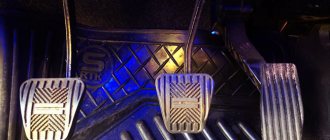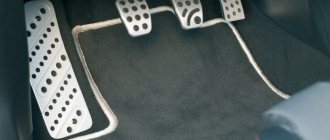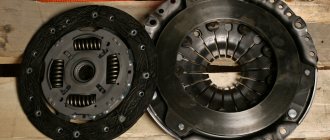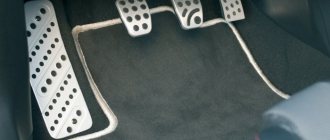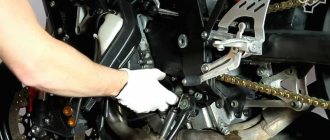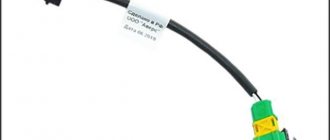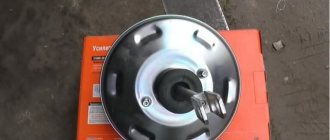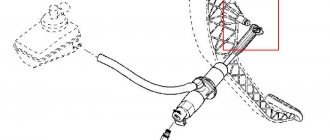The clutch is one of the most important mechanisms in a car. This mechanism ensures that the torque of the car engine is transmitted to the driven disc through the clutch basket. The clutch disc is in constant contact with the flywheel using a spring mechanism. It is affected by the release bearing, the function of which is to disconnect the torque of the motor from the driven disk when you press the pedal. Like all elements of a vehicle, the clutch is subject to wear and various types of problems.
Car owners often do not take into account the existing creaking of the clutch pedal. In fact, this may indicate a number of serious malfunctions. Photo: autoskipper.ru
Why does a squeak occur when you press the clutch pedal?
It is necessary to understand the structure of the clutch pedal. It comes in two types: mechanical and hydraulic. In hydraulics, torque is transmitted using compressed air, but if it is a mechanical drive, then the coupling is carried out using a rigid cable.
Why does a squeak occur when you press the clutch pedal:
- The operating principles of the hydraulic and mechanical systems are very similar and have similar parts. Therefore, creaking can occur for the same reasons. Car enthusiasts divide squeaking into light and heavy.
- A slight squeak may occur when the car is overcooled in winter. The metal can narrow, the lubricant hardens, as a result of which the mechanisms come into less contact with each other, which provokes the occurrence of squeaking.
- Usually it disappears as soon as the car warms up a little and comes into working condition. However, despite the fact that the squeak is light, most often it does not harm the performance of the car, but at the same time it significantly irritates the owner.
- Therefore, the owners of the iron horses want to quickly sort out this creaking noise. The fact is that this creaking can not only get on your nerves, but also indicate some kind of significant breakdown, be a so-called symptom of a serious illness.
Clutch assembly
Transmission cable: replacement
When using a manual transmission correctly, it is necessary not only to monitor the technical condition of this unit, but also to competently handle the gear shift lever directly. Since the main malfunctions in a manual transmission occur when the driver operates the shift lever incorrectly (sharp engagement or “jerking”).
In this case, switching mechanisms, synchronizers, shafts, gears, cables, etc. may fail. We must not forget that over time, the gear shift system, subjected to heavy loads, can also fail. As a result, there is unstable gear shifting, difficulty with shifting, etc.
So, let's look at how to change the manual transmission cable. By the way, replacing manual transmission cables is practically no different from replacing automatic transmission cables. The only difference is the number of cables. The sequence of actions when removing manual transmission control cables is as follows:
- disconnect the wire from the negative terminal on the battery;
- remove the floor tunnel lining, then use special pliers to grab the bent edge of the cable sheath fastening bracket and remove the bracket;
- disconnect the gear shift cable end from the rocker lever pin;
- Grab the spring cotter pin securing the cable tip with pliers and remove it from the hole in the rocker arm;
- remove the battery mounting shelf;
- Squeeze the cable end clamps with pliers and disconnect it from the lever on the manual transmission;
- Remove the end of the cable sheath from the groove of the bracket on the mechanical box;
- Disconnect the end of the gearshift cable from the manual transmission lever and remove the end of the cable sheath from the bracket;
- Remove the “thermal shield” of the additional muffler and remove the cable holder from the hole in the base of the car body;
- Remove the cables under the car;
Read more: How to remove a box on a Matiz
Installation of new cables is carried out in the reverse order of removal. Also, upon completion, it is necessary to adjust the gearbox control drive. Please note that adjustments to the rocker and other mechanisms must be performed as efficiently as possible in order to achieve clear and easy gear engagement.
Why does a squeak occur when the clutch is released?
Very often, along with a squeak, other problems associated with the clutch pedal may arise. Basically, the pedal can be hard to move and is pressed jerkily.
Why does a squeak occur when releasing the clutch:
- In this case, it is necessary to urgently undergo diagnostics, since with further operation of the car, the fork or the cable that connects the clutch pedal to the car parts under the hood may break.
- Most often, the squeak appears when the clutch pedal is released, that is, at moments when there is no pressure on it. When all the mechanisms are under pressure, they work more smoothly. As soon as the pressure decreases, a squeak occurs.
- There are several options to solve the problem. Of course, it is best to remove the pedal, disassemble it and lubricate all the components. However, this manipulation takes a lot of time; even experienced car enthusiasts can do the job for half a day.
Adjustment
Step-by-step instruction
Now we will analyze the whole process step by step. Stock up on a caliper or at least a ruler in advance.
- Open the hood and disconnect the negative terminal on the battery. Now we need to remove the air filter, which hides the components we need
- We remove the mass air flow sensor connector, the adsorber coupler, the rubber supports and tilt the VF housing to the side
- Our clutch fork is located next to the crankcase. On some cars on the secondary market you can also find a sensor moved there by the driver
- Using a tool, say, pliers, we pull the tip towards ourselves in order to free up more space for work
- We take a caliper and measure the distance from the leash to the fork. According to Grant's technical documentation, it should be exactly 27 millimeters
- We adjust the leash according to the thread if the distance does not match
- Then we press the pedal a couple of times, look at the result, and repeat the setting
- Next is the travel of the pedal itself. It should be 14.6 centimeters (+ - centimeter). As already said, it is better if it is flush with the brake
- If even after several adjustments the pedal does not fall into place, then it would be logical to deal with the unit itself
How to eliminate a squeaking clutch pedal in Kalina?
The situation becomes more complicated if the car interior is small, and it is physically quite difficult to get close to this mechanism. The situation is most difficult with small cars, such as the Lada Kalina or Matiz.
How to eliminate a squeaking clutch pedal Kalina:
- You can, of course, simplify the task and remove only the bushings and replace them. When replacing bushings, you can lubricate the parts with machine oil. Many car enthusiasts decide to simplify their task and lubricate the spring with machine oil.
- We do not recommend doing this, as the remaining lubricant will drain, enter the interior, stain the carpet and cause a strong unpleasant odor. You can use a solution of VD-40, which consists of kerosene and machine oil.
- Thanks to the combined composition, the solvent corrodes all the dust that is on the clutch pedal, removes rust particles, thereby eliminating the squeak.
- However, due to the fact that VD-40 contains practically no lubricants, the oil contained in the composition drains quickly, and the squeak can return in just 1-2 days. Therefore, we advise you to use a special lubricant that does not leak and adheres well to the car components.
Repair
Advertisements on NN.RU – Auto
Extend the chassis (frame) on Gazelle Next, Gazelle peasant under a body of 4.2 m, 5.1 m and 6.2 m. Extend the frame on Gazelle Next, Gazelle Gas 3302. Cost: 25,000 rubles.
A wide selection of hydraulic pumps and hydraulic motors of all series: spline hydraulic pump of right rotation. It is used in road construction and... Cost: 1,000 rub.
A special enterprise for the conversion of cargo vehicles produces extensions of the man man, iveco iveco truck tractor.
A special enterprise for converting cargo vehicles into a tow truck invites you to install a tow platform on.
Source: www.nn.ru
How to stop squeaking when pressing the clutch?
Often the cause of a squeak is a cable on which the lubricant has dried. If it is not old, there is no need to completely dismantle it. Just take a syringe and lubricate the cable from the hood and interior.
How to remove squeaking noise when pressing the clutch:
- Push the nozzle of the lubricant bottle deep under the casing and inject the oil. After carrying out the manipulation, do not forget to treat the casing joint with a water-repellent agent to prevent water from entering.
- Usually aerosols help little in such cases, since they do not completely penetrate under the casing. Two drops of oil will save the situation and eliminate the squeak. It is more difficult if the creaking does not occur in the pedal itself, but in the clutch mechanism.
- Typically, this situation is often observed in VAZ cars, where the creaking is caused by the clutch fork and bushing. Lubrication in this area is very difficult due to limited access.
Control pedals
Recommendations
Comments 25
Now I tried it, it didn’t help (( Granta Drive Active 60,000 mileage
A week later I started clicking again. Not so long ago I was driving a Datsum taxi, it clicks like crazy and I sold it to Grant for fuck's sake
There is an opinion that after such improvement the clutch cable breaks after a certain time. I don’t understand whether it’s a coincidence or not, but my cable broke in this particular place, a couple of months after installing a piece of metal-plastic there. Although I can say in support that there are no more clicks. And at the moment, even the newest one does not crunch))
Crunched up to 47 thousand km. Later, it can crunch and there are no more clicks or crunches. Everything became soft and quiet on its own
Curious... My mileage is 43 thousand km. It was necessary to wait))) for the sake of enthusiasm, I’ll take it out in a month and check it.
I’m not saying anything)) it happened to me personally)) I don’t even understand whether this will happen to you or not)))
There was also such a failure. I changed the spring to a stiffer one. It's been quiet for six months now
Yesterday I set the gap to 27 mm and everything worked. It works unsurpassed
I will inspect the gap and pull it out for testing.
I had enough for a week
A week has passed, everything is ok. I read reviews of people who have been riding for 2 years and everything is ok. You will also need to check the 27mm gap.
I generously lubricated the ratchet mechanism with graphite lubricant from Oilwright. Contributed
Lubricated it didn't help. But it slightly relieved the squeak; after all, the hose does not eliminate the squeak, but eliminates the clicks and gives softness to the pressure because the angle of travel of the cable changes.
This method is not for everyone, it didn’t work for me, I changed the cable to a new one, after 3k the same picture happened again. In the photo, 3 machines click, and the 1st one has an automatic machine.
I read your review. Well, the video helped me. Apparently it works for someone and everything is ok, for someone it doesn’t work and there’s no way to fix it.
Before I got behind the wheel of the Granta, I read the primer for it. The clicking noise is produced by the automatic wear compensator for the disc linings and the cable pull. It clicked once a day for about two weeks, at the moment if it clicks once every six months that’s all. Did not do anything!
I read your commentary before installation. Specifically, clicks and not clicks, I have one now and listen to the video, but earlier everything creaked and clicked. I've been driving for 2 months and it's constantly clicking and from time to time it even feels like the plastic is breaking with a crunching sound being squeezed out. At this point, a week has passed and everything is ok. And one of the main advantages was the soft pedal. We simply change the angle of travel of the cable, but not the most.
My pedal was always soft, there were clicks (on the newest one) once per squeeze. When I worked as a driving instructor, there were also clicks all the time, but one at a time, not the most.
Right now I also have one for the squeeze. Well, I heard it myself.
I set the gap to 27 mm and filled the ratchet mechanism with oil from a syringe and silicone from a balloon. There were no clicks at first, and there was no creaking.
Source: www.drive2.com
How to eliminate a squeaking clutch pedal?
The common occurrence of squeaks indicates wear of the mechanisms, or lack of lubrication. If the car is front-wheel drive, the situation becomes simpler.
How to eliminate a squeaking clutch pedal:
- In order to lubricate the fork, you just need to remove the rubber plug and apply lubricant to the axle using a bottle with a thin spout.
- Sometimes drilling the crankcase in the place where the axle is attached helps improve the situation. There are mechanisms in which the fork is in contact with the stem.
- To lubricate it, you need to move it to the side and lubricate it in the place where it contacts the rod.
- In this case, the work is completed in just a few minutes, but you will have to lie under the car and do the dirty work.
It is best to lubricate with oil without removing the gearbox. Otherwise, the situation may worsen due to the complexity of dismantling and installing the gearbox. If the creaking is caused by a fork on the crankcase, you will have to completely dismantle the mechanism, reassemble it, and lubricate it.
Solution
In almost all cases, the problem of a squeaking clutch pedal can be eliminated with the help of lubricant. To do this, you need to lubricate all intensively rubbing parts.
Experts recommend using thick grease (CV joint or something like that) as a lubricant. If the car was designed in such a way that it is impossible to get to the pedal elements or spring, do not despair - there is a way out. Use a slotted screwdriver for this. Apply a little lubricant to its metal part, after which you can reach the necessary places with a screwdriver.
There is also a possibility that the squeak does not come from the pedal, but from the clutch fork. During operation, it serves as a place for dirt and used lubricant to accumulate. Because of this, this unpleasant sound appears.
In order to eliminate squeaking in the clutch fork, it must be washed from dirt. Naturally, it is very difficult to reach it, so this must be done through the engine compartment. To clean, you can use carburetor cleaner - it will do the job perfectly. Once you have removed all the accumulated dirt, apply a coat of thick lubricant to the fork.
Other possible squeaks
In addition to the clutch pedal, the reasons for the appearance of squeaks we have already figured out, the reason may lie elsewhere. For example, if the clutch mechanism uses a cable drive, then it is often the cause of unpleasant sounds. If this is the case, simply changing the lubricant will not help solve the problem. To do this, it is necessary to replace the clutch cable.
If you hear a squeak somewhere from the engine, this indicates a faulty release bearing. To fix this problem, you will most likely need to replace the release bearing.
The clutch pedal may make peculiar noises due to the clutch actuator. This is due to the fact that all the work of the clutch is mechanical friction of the working parts. Naturally, the appearance of noise cannot be avoided. In order to get rid of annoying sounds, you will need to periodically lubricate the rubbing parts. Because you will not be able to control a constant level of lubrication - everything is washed off during operation.
There is a more difficult way out of this situation. Using a skilled turner, turn the bushing between the rubbing parts from a softer metal or polycarbonate. In this case, the occurrence of unpleasant sounds will stop, because the friction of different materials will not create such noise as two materials of the same density and structure create.
Published: August 25, 2015
Clutch pedal creaking VAZ
Please note that in some car models, squeaking when pressing the clutch pedal may occur for certain reasons. In an ordinary car, a Zhiguli is a clutch cable and fork. In hydraulically driven vehicles such as Mitsubishi, lubrication is most often required at the junction of the gearbox and clutch. Most often, VD-40 lubricant is enough to eliminate the cause of the squeak.
Dismantling
You can close your eyes to a slight creaking noise that quickly disappears after warming up, but loud sounds get on your nerves and need to be eliminated. They may indicate serious damage and failure of some parts of the unit.
Symptoms of malfunction, diagnostics, solutions
| Sign | Cause and remedy |
| Short pedal stroke | Adjust the length of the cable. Check the integrity of metal fibers. Most likely delamination or bending. |
| The clutch drags at speed, it is difficult to shift into higher gears. | The flywheel is bent or damaged. The gripper teeth are worn. Replacing the flywheel and related consumables. |
| Slipping when activating first gear and increasing speed with the accelerator pedal. | Replace friction linings, disk, clean the drive from old grease |
| Sharp jerks when turning on / changing gears. | The pressure plate is damaged, replace the basket. |
| Whistle when activating first and subsequent speeds | Install a new release bearing |
| Crackling, knocking, crunching noise when shifting into up/down gears | Wear out the damper spring, replace it with a new one, lubricate the entire drive mechanism. |
| The lever falls, falls, rattles | Excessive stretch of tensioner. Replace with a new one, install bushings. |
In what cases is it recommended to contact a service station?
Unfortunately, not only squeaking occurs, but also serious problems, among which the most unpleasant and difficult to fix is clutch slipping, which is not uncommon for this model. In such a situation, the only way out would be a visit to the service station. On average, a clutch kit will cost 5 thousand rubles, plus 1-2 thousand rubles. – installation fee.
A visit to a service station can be avoided if you properly care for the transmission and follow the recommendations of experts:
- If possible, do not overstress the clutch. Try to move off gently at a low crankshaft speed (watch the tachometer readings). Otherwise, due to natural inertia, slippage with accelerated wear will occur.
- Do not release the pedal too slowly, as if on a truck: do not be afraid - the car will not stall. Modern cars with synchronizer are equipped with systems that do not involve, for example, double squeezing with re-throttle. In general, feel free to take your foot off the pedal. What was useful in Soviet times is now harmful, and light pressure leads to unwanted slippage and a reduction in resource.
- Do not tow other vehicles when driving uphill. This is especially harmful on slippery, uneven roads.
- Do not hold the clutch in the depressed position, but remove your foot from the pedal, placing the lever in neutral. This loads the box, but spares the clutch.
Thus, how long the clutch will last and how often it will be disturbed during operation depends only on you. Remember: any malfunction can be easily fixed in a timely manner. And if you don’t have the appropriate skills, it’s better not to get down to business, but entrust the responsible mission to professionals.
Advice!
The clutch pedal should be installed at the level of the other two, otherwise there is a chance that the reverse gear simply will not engage.
If all the manipulations to lubricate all rubbing parts and mechanisms did not help you, and the problem remains unresolved, then in such a situation the best option would be to contact a specialized service center for diagnostic analysis.
Because solving problems with the gearbox and clutch in advance can prevent you from unexpected breakdowns and further expensive repairs.
- For lubricants in hard-to-reach areas, it is best to use WD-40 or a silicone lubricant in spray form. Thus, the material will be better distributed on the surface and will reach all places that are difficult to reach manually.
- It is recommended to lubricate the clutch pedal and fork cable fastenings with graphite lubricant, which has a beneficial effect on such mechanisms and holds well on devices subject to constant load.
List of online stores selling parts (Moscow, St. Petersburg, Kyiv regions)
| № | Name | Address |
| 1. | "Autoall" | www.avtoall.ru |
| 2. | "Original part" | lada-original.ru/ |
| 3. | "Navigator" | www.navigator-63.ru/ |
| 4. | "TOTAX" | totax.com.ua |
| 5. | "Zakupka" | kiev.zakupka.com |
| 6. | "How much" | www.avtostore.spb.ru |
Review of Manufacturer Prices
| Manufacturer | Price, rub.) | Resource (Thousand km) |
| LADA 21901-1602210 original | From 634 | 100 |
| ASPCC260210 | From 465 | 75 – 80 |
| BRAND 219011602210 | From 300 | 75 — 80 |
| Plastic cable lead 21901-1602266-00 | From 150 | 40 |
| 21901-1602210-00 clutch cable assembly | From 550 – 600 | 75 |
| 21901-1602210-00 clutch cable assembly | —/— | 75 |
| JSC "ProSport" 26594516 | From 500 | 80 – 85 |
| JSC Vortex 5465465 | From 550 | 80 — 85 |
*prices are current as of October 29, 2018.
Recommendations for the selection of parts and components
The vast majority of spare parts for the Lada Granta are domestically produced. Foreign analogues are not in demand due to their high cost. Compared to “our” products, imports are 10–15% more expensive. The workmanship is at the same level.
When purchasing spare parts and components, always give preference to high-quality, original parts. Check the correspondence of catalog items with the actual data specified in the operating instructions for the technical device.
If you have no experience in car maintenance, seek qualified assistance from service station specialists.
Consequences
This operation does not cause any negative consequences. As the clutch discs wear, the rod will gradually come back out. However, when new clicks begin, the time will come to change the clutch itself.
The design of the Priora clutch drive cable can be seen in the video:
- Vehicle track width: determine correctly
- Homemade strobe for setting the ignition
- How to make a car strobe light with your own hands
- Vehicle understeer and oversteer
Features of the Lada Priora clutch
Any motorist interested in how to adjust the clutch on a Priora should know about the presence of the drive cable auto-adjustment function. That is, VAZ designers took care of the owner and saved him from the need to constantly adjust the clutch drive mechanism during operation. The same ratchet-type system is installed on Kalina, but both there and on Priora it is impossible to do without periodic adjustments. This factor has been proven by practice and forum discussion pages.
How does an automatic cable tensioner work?
In the release drive on the VAZ 2170, there are no gaps as a concept, hence the name - backlash-free clutch. The ratchet mechanism serves to compensate for the working length of the cable as the driven disk linings wear out
To understand the process, it is important to accept the following data:
- During operation, the driven disk wears out and its linings become thinner - as a result, the release bearing and basket springs shift towards the gearbox.
- Accordingly, the fork at the place where the cable is attached moves towards the radiator.
- The spring located on the bushing of the adjusting mechanism is compressed at this time and tightens the clamps of the cable tip.
- As a result, the tip is pulled out of the driver, due to which the wear of the disc linings is compensated.
For those who don’t yet know how to adjust the clutch on a Priora themselves, it is important to take into account the moment when the linings are new. In this case, when releasing the pedal, the ratchet bushing will only lightly touch the bracket without releasing the clamps
Therefore, the toothed tip of the cable will not move relative to the housing. Only as the linings wear out does the spacer sleeve release the spring-loaded clamps and the cable tip extends to the amount necessary to balance the worn parts.

